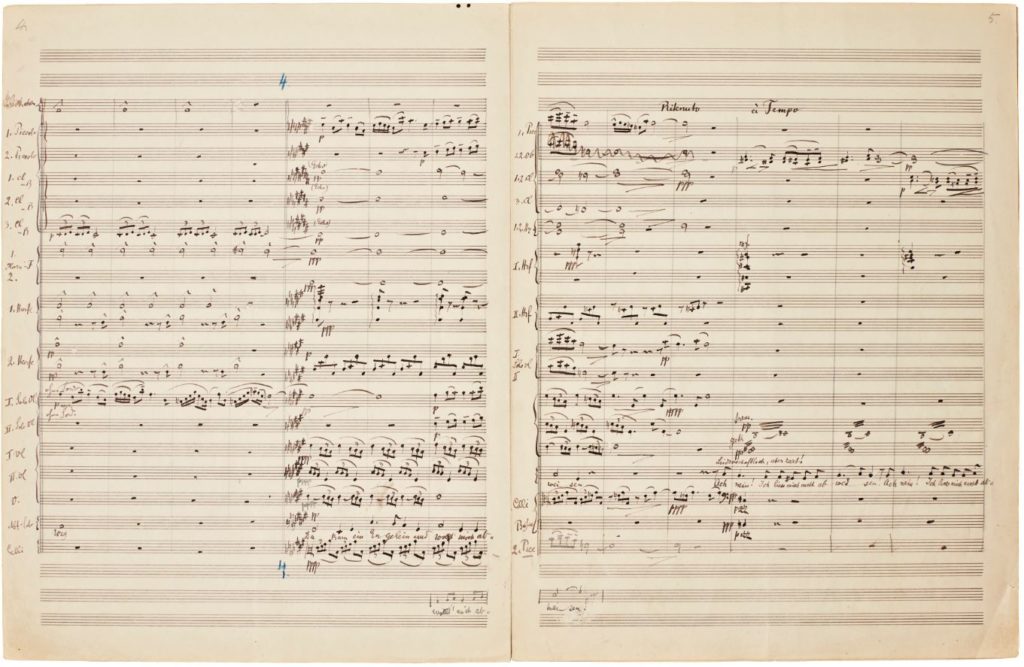Lied 3: Trost im Ungluck
Trost im Unglück describes the feelings of somebody trying to move past a lost or rejected love, comforting himself with the assurance that he loved her out of foolishness and can live without her. Year 1892. Lied 3: Trost im Ungluck. ‘Trost im Ungluck (aus der “Knaben Wunderhorn”). Eine Humoreske (No. 3) fur Singstimme mit Orchester […]
Lied 2: Verlor’ne Muh!
Verlorene Müh’ is another dialogue song, and it is in the distinctive Swabian dialect. It is a sort of fruitless serenade in a playful 3/8 rhythm. It is quite similar to the famous song by Brahms called Vergebliches Ständchen, but with a reversal of gender roles. The foolish girl makes numerous attempts to entice a […]
Lied 1: Der Schildwache Nachtlied
Der Schildwache Nachtlied is a complex military-style song with trumpet calls and drum rolls, but it is also a dialogue song. The sentinel’s defiant rejection of joy and love is three times interrupted by more tender music setting words of his beloved. He rejects these, becoming more defiant and firm, building to an actual sentinel’s […]
Movement 5: “Aufersteh’n”. Im Tempo des Scherzos. Wild herausfahrend
At the same speed as the Scherzo. In a wild outburst. The Scherzo’s “cry of despair” is recalled, then answered by a hesitant statement on the horns of the emerging “Resurrection” theme. There follows a “voice calling in the wilderness”, again on the horns, but this time offstage, before the contours are once again blurred […]
Movement 4: “Urlicht”. Sehr feierlich, aber schlicht

Primeval Light. Very solemn but simple (In the manner of a chorale). After the “tormenting” questions of the opening movement and the grotesque dance of the Scherzo, humankind is freed from uncertainty and doubt. The Wunderhorn-Lied brings with it the first ray of a light that will shine in glory at the end of the […]
Movement 3: In ruhig fliessender Bewegung
Scherzo bases on Gustav Mahlers’ Lied 6: Des Antonius von Padua Fischpredigt (Des Knaben Wunderhorn, 1892-1898). See Arnold Bocklin (1827-1901). With a gently flowing movement. The tragic, or at least pessimistic, conception of this symphonic Scherzo seems worlds away from the humour of the Wunderhorn song in which St. Anthony preaches to the fishes, who understand nothing of […]
Lied 9: Selbstgefuhl!
The final song, “Selbstgefühl” (My mood), starts with a dynamic of forte. To maintain a high level of playfulness, the tubist must observe the strict dynamic indications. Mahler indicated that the octave in the left hand of the piano part can be omitted throughout the song if the additional low notes create too thick of […]
Lied 8: Nicht wiedersehen!
Balancing the soft low texture with piano remains one of the main challenges for tubists in the penultimate song in this collection, “Nicht wiedersehen!” (Never to meet again). It is scored very low on the piano and would be easy to lose the melody inside of the harmony of the accompaniment. Mahler instructs the pianist […]
Lied 7: Scheiden und Meiden
“Scheiden und Meiden” (Partings) explores the metric juxtaposition of two versus three used in “Ablösung im Sommer.” “Trumpetlike” is the first expression in the music as F major arpeggios rise from the tuba and piano. Despite the repeated ascending passages, the first dynamic is piano so the tubist should strive to be precise to start […]
Lied 6: Ablosung im Sommer
Misprints are rare, but this song contains one incorrect note in the piano part. In measure 3 of the IMC edition, the first left hand note should be A instead of F. Few instances exist where Mahler uses a hemiola effect in the piano. Measures 10 and 11 are a wonderful example of this effect, […]
